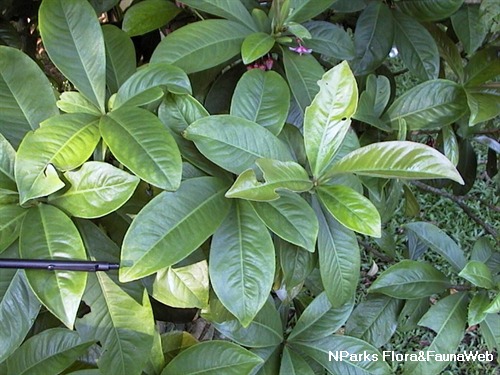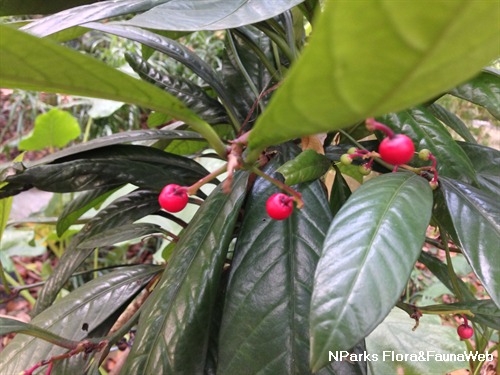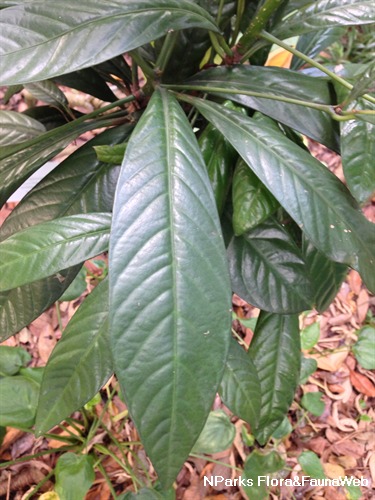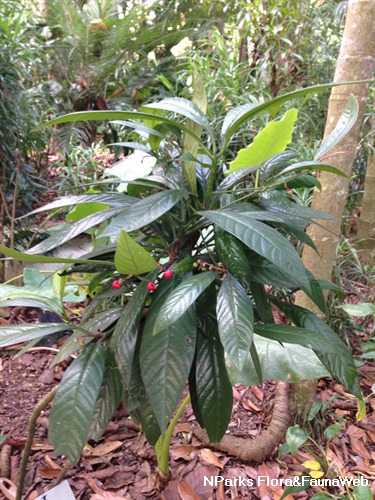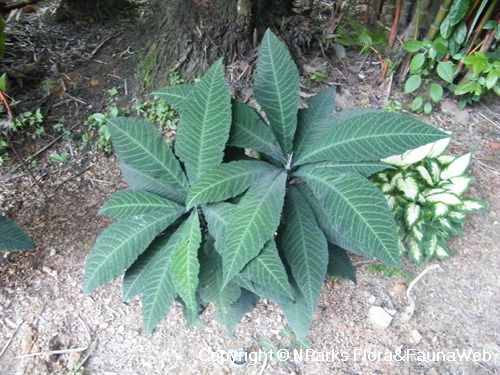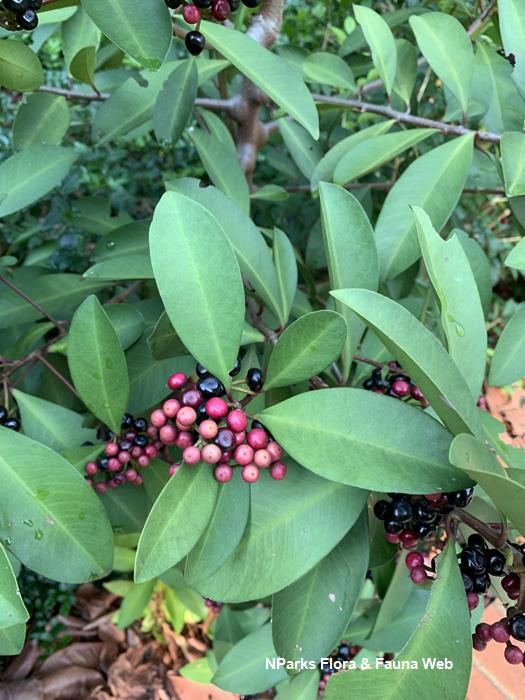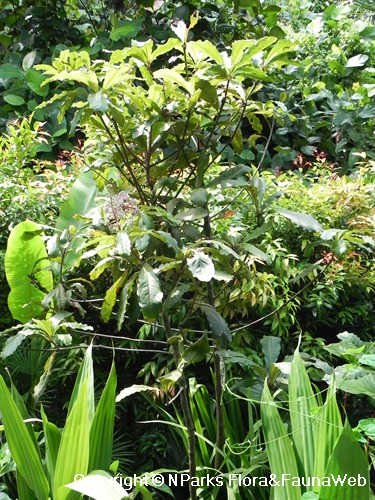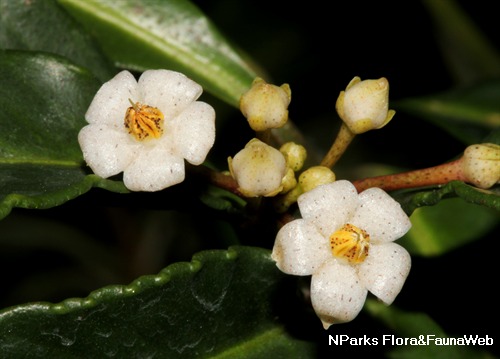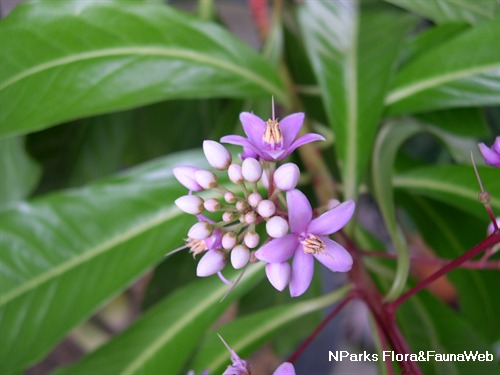
Back
Ardisia purpurea Reinw. ex Blume
| Family Name: | Primulaceae |
| Synonyms: | Ardisia lanceolata Roxb. |
| Common Name: | Great Ardisia, Medang Sangit, Merambung |
Name
Classifications and Characteristics
| Plant Division | Angiosperms (Flowering Seed Plants) (Dicotyledon) |
|---|---|
| Plant Growth Form | Tree, Shrub |
| Lifespan (in Singapore) | Perennial |
| Mode of Nutrition | Autotrophic |
| Plant Shape | Irregular |
| Maximum Height | 10 m |
Biogeography
| Native Distribution | Thailand, Sumatra, West Malaysia, Singapore, Borneo, Java, and Sulawesi |
|---|---|
| Native Habitat | Terrestrial (Primary Rainforest, Secondary Rainforest) |
| Preferred Climate Zone | Tropical |
| Local Conservation Status | Native to Singapore (Critically Endangered (CR)) |
Description and Ethnobotany
| Growth Form | It is shrub or tree up to 10 m tall. |
|---|---|
| Foliage | Its alternate, stalked leaves have almost leathery leaf blades that are usually elliptic-oblong, and 15–28 by 5–9 cm, with colourless, scattered glandular dots. |
| Flowers | Its stalked flowers are pink or red, 9–10 mm long, and up to 1.7 cm wide. They are found in clusters of 4–10 together on shoots that develop from the ends of leafy twigs. |
| Fruit | Its smooth fruits are round, slightly depressed, dark red to black when mature, and up to 7.5 mm wide. |
| Habitat | It grows in lowland and hill evergreen forests up to 500 m altitude. |
| Associated Fauna | Its flowers are insect-pollinated. |
| Cultivation | It can be propagated by seed. |
| Etymology | The genus Ardisia is derived from the Greek word 'ardis' which means a point and refers to the pointed anthers of the plant. |
| Ethnobotanical Uses | Timber & Products: The very durable wood is used to make house-posts. |
Landscaping Features
| Landscaping | It is suitable for parks and gardens for its ornamental flowers and fruits. |
|---|---|
| Desirable Plant Features | Ornamental Flowers, Ornamental Fruits |
| Landscape Uses | General, Parks & Gardens, Small Gardens |
Fauna, Pollination and Dispersal
| Pollination Method(s) | Biotic (Fauna) |
|---|---|
| Seed or Spore Dispersal | Biotic (Fauna) |
Plant Care and Propagation
| Light Preference | Semi-Shade, Full Sun |
|---|---|
| Water Preference | Moderate Water |
| Plant Growth Rate | Moderate |
| Rootzone Tolerance | Moist Soils, Well-Drained Soils, Fertile Loamy Soils |
| Propagation Method | Seed |
Foliar
| Foliage Retention | Evergreen |
|---|---|
| Mature Foliage Colour(s) | Green |
| Mature Foliage Texture(s) | Leathery |
| Foliar Type | Simple / Unifoliate |
| Foliar Arrangement Along Stem | Alternate |
| Foliar Attachment to Stem | Petiolate |
| Foliar Shape(s) | Non-Palm Foliage (Lanceolate, Elliptical, Oblong) |
| Foliar Venation | Pinnate / Net |
| Foliar Margin | Entire |
| Leaf Area Index (LAI) for Green Plot Ratio | 4.0 (Tree - Dense Canopy) |
Floral (Angiosperm)
| Flower & Plant Sexuality | Bisexual Flowers |
| Flower Colour(s) | Pink |
|---|---|
| Flower Grouping | Cluster / Inflorescence |
| Flower Location | Axillary |
| Flower Symmetry | Radial |
Fruit, Seed and Spore
| Mature Fruit Colour(s) | Black, Red |
|---|---|
| Fruit Classification | Simple Fruit |
| Fruit Type | Fleshy Fruit , Non-Accessory Fruit |
References
| References | Lindsay, S. et al. (2022). Flora of Singapore: Checklist and bibliography. Gardens’ Bulletin Singapore 74(Suppl. 1): 3–860. |
|---|
Image Repository
Others
| Master ID | 1435 |
|---|---|
| Species ID | 2728 |
| Flora Disclaimer | The information in this website has been compiled from reliable sources, such as reference works on medicinal plants. It is not a substitute for medical advice or treatment and NParks does not purport to provide any medical advice. Readers should always consult his/her physician before using or consuming a plant for medicinal purposes. |

